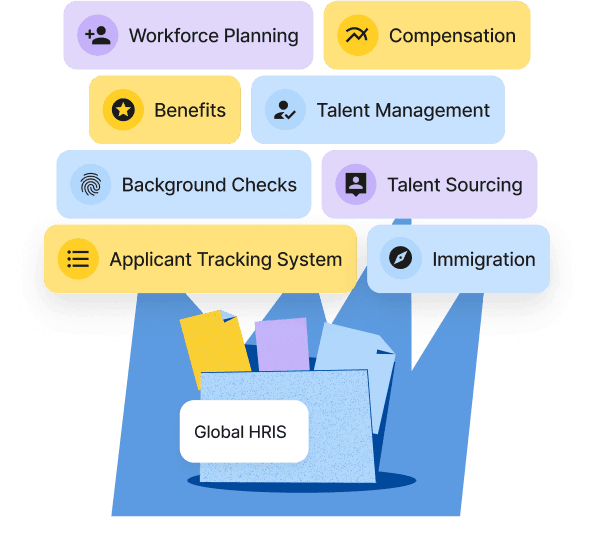Article
29 min read
The ROI of HR Consolidation with an All-In-One HR Tool, Deel HR
Global HR

Author
Lorelei Trisca
Last Update
November 04, 2025
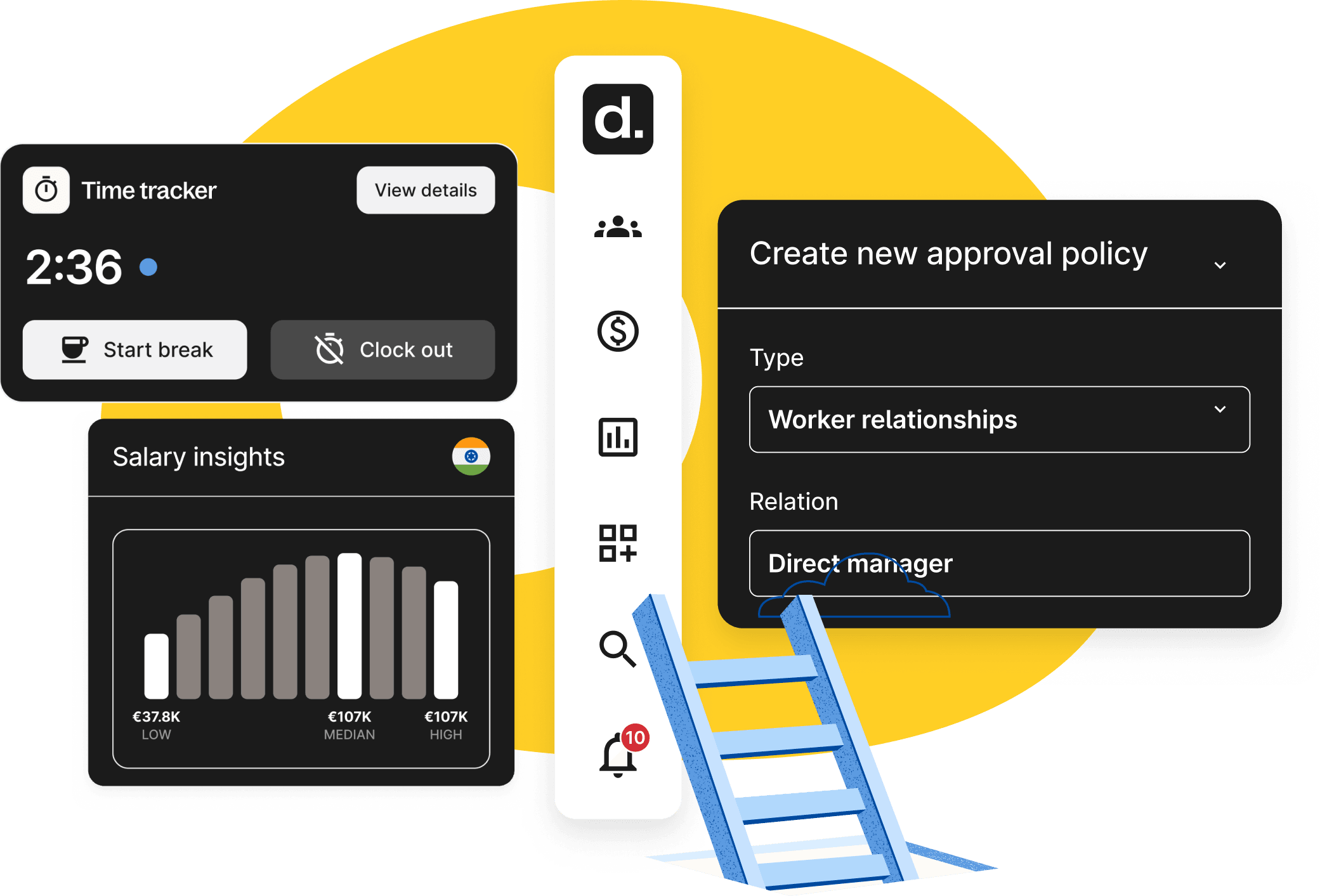
Table of Contents
The hidden costs of scattered HR tools and systems
What happens when you unify your HR management with Deel?
Move from fragmented to global consolidated HR with Deel HR
Key takeaways
- An all-in-one HR solution is a single platform that manages every stage of the worker lifecycle, whether they’re contractors, employees, or hired through an EOR. It centralizes tasks like onboarding, payroll, time off, performance, and offboarding, so HR teams don’t need to juggle multiple disconnected tools.
- The benefits of HR consolidation extend beyond cost savings to enhance speed, accuracy, and decision-making while also reducing administrative overhead and risk.
- For global teams, all-in-one tools like Deel HR serve as the foundation for scaling. Our platform provides the infrastructure to hire anywhere, manage locally, and stay on top of the red tape, all without adding extra systems or headcount.
Juggling a patchwork of HR systems can drag your team into a never-ending cycle of manual tasks, hidden costs, and compliance headaches—especially as your workforce becomes more global and dynamic. Today, HR professionals are overwhelmed by disjointed tools that slow decision-making, increase errors, and leave both managers and workers frustrated.
Only 43% of HR professionals rate their organization’s HR technology as effective, according to SHRM’s 2025 State of the Workplace report. The solution isn’t to purchase more tools. It’s to eliminate many of them by combining your HR operations into a single all-in-one platform.
With worldwide expertise supporting over 37,000 businesses, Deel understands these pain points firsthand and has revolutionized how organizations scale by consolidating HR operations into one seamless platform.
This guide explains how HR consolidation works and how to deliver a better experience at every stage of the worker lifecycle. Also, you'll learn how companies like PostHog and Responsible Cyber have recaptured lost hours and avoided costly risks, all while empowering HR teams and delivering a better employee experience.
The hidden costs of scattered HR tools and systems
When evaluating the benefits of switching to an all-in-one HR platform, it’s tempting to start by comparing subscription fees. Usually, this is a monthly or annual fee for every HR professional who uses each tool in your tech stack. While they do add up quickly, these costs are a drop in the ocean compared to the indirect costs of paying for scattered HR solutions. Here’s where the real money drains away.
Fragmented data and reporting
When your people data lives in five different tools, generating accurate reports can take hours, if not days. Your HR teams need to pull each data set, then clean it manually, and cross-check the information against the others. This process creates blind spots that can derail decision-making or expose you to risk. Here are a few common examples:
- Headcount reporting becomes a manual reconciliation exercise across HRIS, EOR tools, and contractor spreadsheets.
- Time-off balances in your HR software don’t sync with payroll, causing discrepancies in pay.
- DEI or attrition analysis is limited because key fields like job title, location, or contract types are inconsistent across platforms.
- Compliance audits are slow because contracts, policy acknowledgments, and performance data are stored in different systems (or worse, in email threads).
Wasted time on duplicated admin
Disconnected systems force HR teams into a loop of repetitive manual tasks. Need to change a worker’s surname? You’ll need to enter the update in every system, including HRIS, payroll, benefits, and learning management. What about if the worker moves house or adds a dependent? You’re back at it again, re-entering the same data across multiple tools. It’s inefficient, error-prone, and massively time-consuming.
As a result of wasting resources, 62% of HR departments operate beyond capacity, and over half are understaffed, according to SHRM. This is unsurprising, given that so much of the team’s time is consumed by low-value administrative work.
Deel customers have seen measurable savings by consolidating their HR tasks into our single platform. For example, product development software company PostHog saved $50,000+ annually and 160 hours per month on HR tasks by centralizing processes and removing fragmented tools.
Risk of errors and compliance gaps
Every manual touchpoint increases the potential for human error. An outdated address in one system can delay tax documents, while a missed contract update could lead to legal exposure. When HR tools are spread out, it’s easy for data to become inconsistent or flat-out incorrect.
This risk becomes particularly acute for global and remote-first organizations that must navigate diverse tax laws, employment classifications, and regulatory frameworks. It’s no wonder that compliance remains one of the most stressful aspects of HR operations.
The good news is that consolidating into a single platform provides measurable compliance savings for companies. For example, cybersecurity company Responsible Cyber avoided $12,000 in legal costs by relying on Deel’s built-in compliance infrastructure instead of hiring external legal counsel.
Poor worker experience across the lifecycle
A disjointed HR experience slows everything down and drives your people away. If workers have to juggle multiple platforms to request time off, update personal information, or access payslips, it sends a message that the company isn’t built to support them. They’ll leave and create new recruitment costs for the business.
It’s also inefficient for the HR team. According to SHRM, 57% of HR departments lack the staff to manage individual workloads effectively, and every redundant task makes the situation worse.
But when companies double down on streamlining their tools and processes, companies like ThirstySprout have saved up to 7 to 10 hours per hire by streamlining contractor management and onboarding processes. It’s a win-win for the workers involved and HR people behind the scenes, who now have additional time and resources to spend on more value-adding tasks.
What happens when you unify your HR management with Deel?
Once you’ve closed the gaps created by fragmented tools, switching to an all-in-one platform unlocks an entirely new way of working. From better visibility to smarter workflows, here’s what happens when your people processes work in harmony from a central system.
1. Centralized worker records
When your people data is scattered across systems, every question becomes harder to answer: How many workers do we have? Where are they based? Who’s due for a review, a raise, or a contract renewal? Without a single source of truth, the information feels unreliable.
With Deel, all worker records—whether contractors, EOR hires, or direct employees—are managed in a single, unified platform. That means no more reconciling spreadsheets with HRIS exports or cross-checking contractor tools with payroll platforms. The result is fewer errors, faster answers, and more confidence in your data.
Customer success story
PostHog’s experience is familiar to many high-growth companies—using one platform for EOR and contractor management and another for HRIS. This approach was labor-intensive and drained team resources. Once the company consolidated everything in Deel, they benefited from cleaner data and smoother collaboration across their HR workflows. PostHog now has a single source of truth for its people operations to support stronger decision-making.
It was a real hassle trying to juggle all these separate processes on different platforms within the same team, consuming a ton of our time. To make matters worse, the other provider’s user interface was far from user-friendly, leaving our team members pretty frustrated.
—Charles Cook,
VP of Operations and Marketing, PostHog
2. Seamless workflows across every stage of the worker lifecycle
HR processes span departments, systems, and time zones. In fragmented environments, that means friction: new hires chasing logins across multiple tools, managers improvising performance reviews, and HR manually reminding people to complete tasks.
Deel removes that complexity and boosts HR efficiency. Onboarding, offboarding, document signing, and performance tracking all happen in one place, automatically triggering the right actions at the right time.
Customer success story
Since remote engineering company ThirstySprout connected Deel with its internal communication tool, the team can make seamless updates right inside the platform they already use, with no extra steps or missing data. They’re easily connected with their HR system right from the flow of their work.
As most of our work gets done in Slack, the Slack integration and its ease of use are great. Teams don’t have to log out and go to the HRIS to type in their stuff now. They just Slack it, and all of a sudden, everything is documented and synced.
—David Stepania,
Founder, ThirstySprout
3. Global compliance is baked in
Hiring across borders introduces a long list of moving parts, such as local employment laws, tax codes, contract requirements, and mandatory benefits, all of which vary by country. When HR tools are disconnected, managing these details becomes a patchwork process. Some companies rely on local legal support, others use a DIY approach, and most end up somewhere in between, spending more time and money than planned and still feeling uncertain.
An all-in-one platform with built-in compliance changes that. Deel provides pre-vetted contract templates, country-specific policy guidance, and ongoing regulatory updates across 100+ countries. That means HR teams can hire globally without needing a compliance expert for every country or taking unnecessary risks.
Customer success story
Before switching to Deel, Singapore-based company Responsible Cyber managed compliance across borders, employing workers in Tunisia, Vietnam, France, and the UK.
The complexity of the red tape involved led them to seek external support at incredible costs. But with Deel, everything they needed to stay compliant was already in the system.
When it comes to dealing with local laws and tax regulations in multiple countries, relying on Deel is a game-changer. It would have been impossible for us to manage these topics in-house, with extremely costly legal services. Now, I can focus on growing our business while Deel takes care of the hiring logistics.
—Dr. Magda Chelly,
Co-Founder & Managing Director, Responsible Cyber
4. Scalable infrastructure for global-first organizations
Expanding into new markets typically involves implementing new systems or creating workarounds to address local differences in payroll, contracts, or worker classifications. What starts as a lean tech stack quickly becomes a maze of region-specific vendors and manual processes. And, instead of supporting growth, your HR setup becomes something you constantly have to manage around.
Deel offers a different approach. It’s built to support contractors, EOR hires, and direct employees worldwide in an all-in-one system. That means your team doesn’t need to spin up new workflows or hire extra ops staff every time you enter a new region, as the infrastructure is already there.
Customer success story
When sales execution platform Outreach started hiring globally into five new countries, it struggled to find a platform that could keep up with its growth without adding more complexity. Instead of using four separate vendors, Deel offered a streamlined solution:
Our biggest challenge was not having a unified system to manage and pay our global workforce. We needed a comprehensive solution for HR and payroll, and that’s where Deel came in.
—Stephen Epling,
Vice President of Global Rewards and Workplace, Outreach
5. Better decisions, faster, with connected reporting
When data is split across different systems, reporting becomes a time sink. However, with an all-in-one platform, reporting is pre-built into the system. Deel connects data from contracts, payroll, time off, and performance so HR teams and business leaders can access accurate insights quickly. The lack of reconciliatory work means there are no delays.
Customer success story
Previously, The Landbanking Group, a nature fintech company, used three separate tools to manage documents, records, and reporting. The setup created delays, added friction, and made it harder to keep everything in sync.
With Deel, the team moved everything into one system. The Landbanking Group now manages worker data, automated HR document flows and generates reports without toggling between platforms. The result is faster and more consistent admin that’s far less of a burden.
Having everything in one system is incredibly convenient. Generating reports is swift and effortless. With Deel, everything is safe, secure, and easy to find.
—Leigh Attwood-Smith,
Platforms and Processes, The Landbanking Group
6. Empowered HR teams, managers, and workers
Self-sufficiency across your workforce takes the pressure off HR and improves the experience for everyone. Instead of logging endless service requests, workers don’t need to chase down documents, ping HR for policy details, or rely on clunky systems just to request time off. At the same time, HR teams spend less time troubleshooting and more time driving the work that matters.
Customer success story
At customer intelligence company Feedier, HR was the gatekeeper for every update. Time-off approvals and basic changes like job titles or reporting lines had to go through one person, managed mostly through Google Sheets. It slowed everything down and made it hard for managers to take ownership of their teams and for workers to receive the needed information.
Switching to Deel helped them break that pattern. Now, team leads run their own workflows without needing constant support. HR has better oversight without doing everything manually. The result is a 50% reduction in HR administrative work, and the entire process is more structured, with fewer delays and far less back and forth.
Handling HR tasks in spreadsheets was exhausting — every update and approval had to go through me. Deel removed that bottleneck, giving team leaders the tools to manage their teams smoothly.
—Wassim Bejjani,
Operations Specialist, Feedier
Deel HR
Move from fragmented to global consolidated HR with Deel HR
Deel HR is a plug-and-play platform built to manage your entire global workforce across countries, currencies, contract types, and employment models. When you onboard to any Deel product, you automatically receive access to powerful HR tools designed to simplify your operations and reduce compliance risk as you scale.
Global HRIS
Access robust, built-in HRIS features included at no extra cost to manage your complete workforce from one central system. Everything stays compliant, updated, and auditable across 100+ countries. The HRIS includes:
- Time-off management
- Org charts for every worker type
- Digital employee records
- Secure document workflows
- Onboarding and offboarding flows (including device procurement and recovery)
- Customizable approval flows
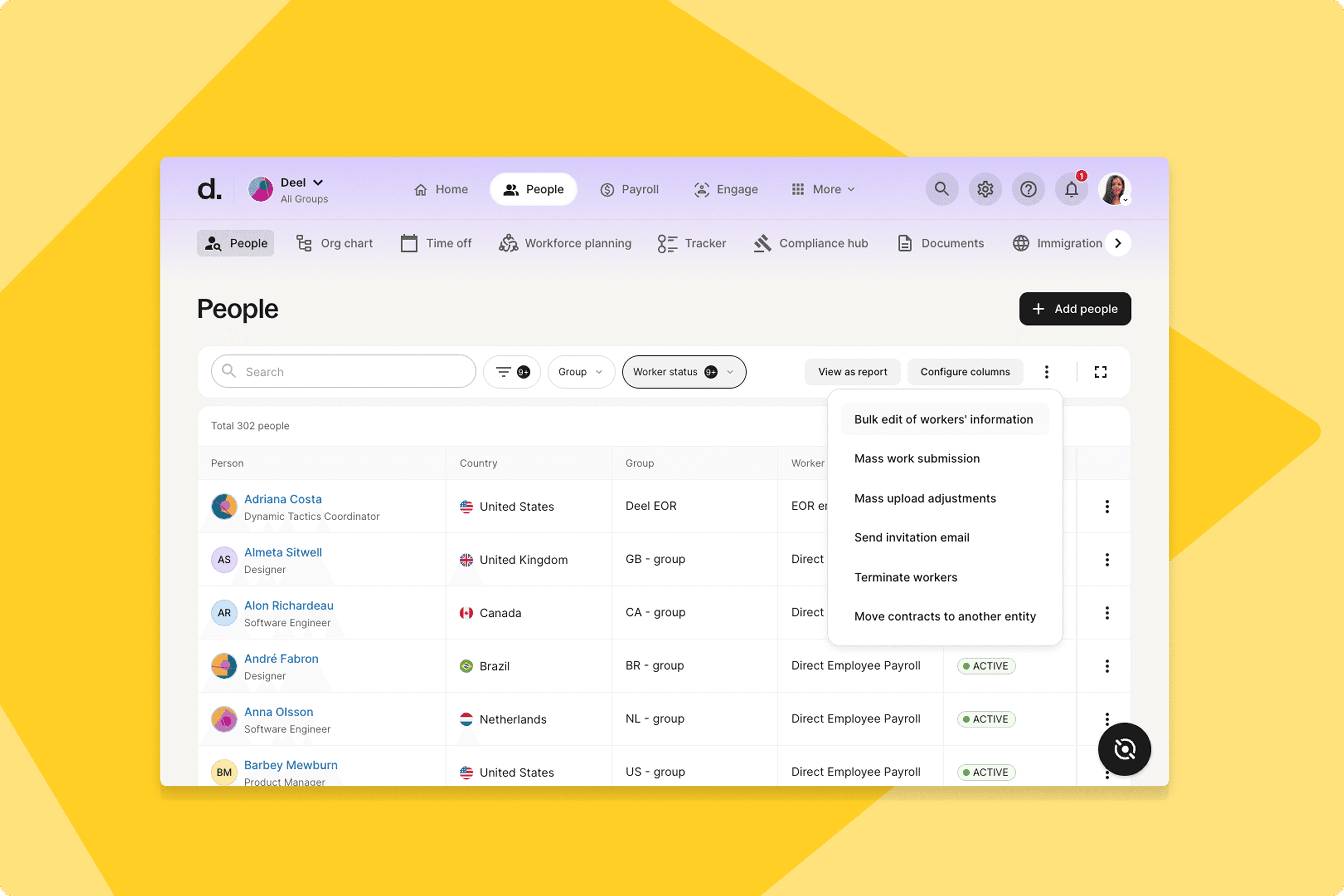
Global HRIS: Manage all worker types—EOR employees, direct employees, contractors—with one tool, regardless of where they are located
Deel Engage
Support people development with automated performance management tools, tracked goals, and built-in surveys.
With Deel Engage, you can set structured review cycles, automate probation period check-ins based on local regulations, and measure worker engagement at scale.
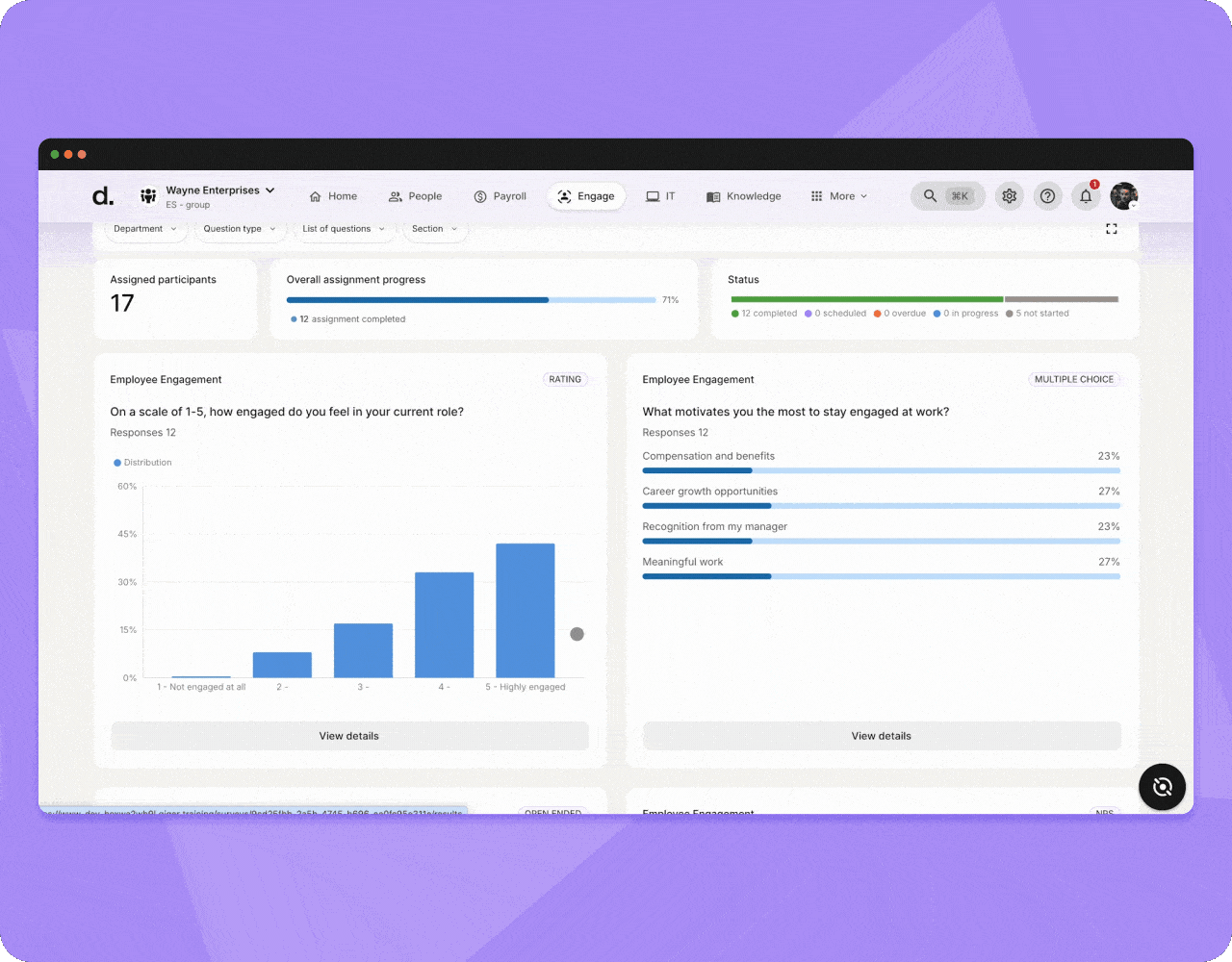
Deel Engage: Survey reporting and dashboards
Deel Compensation
Plan and manage global compensation with consistent, market-aligned pay structures. Create and maintain compensation bands across roles and locations, connect pay to performance, and align comp decisions with budget and workforce plans.
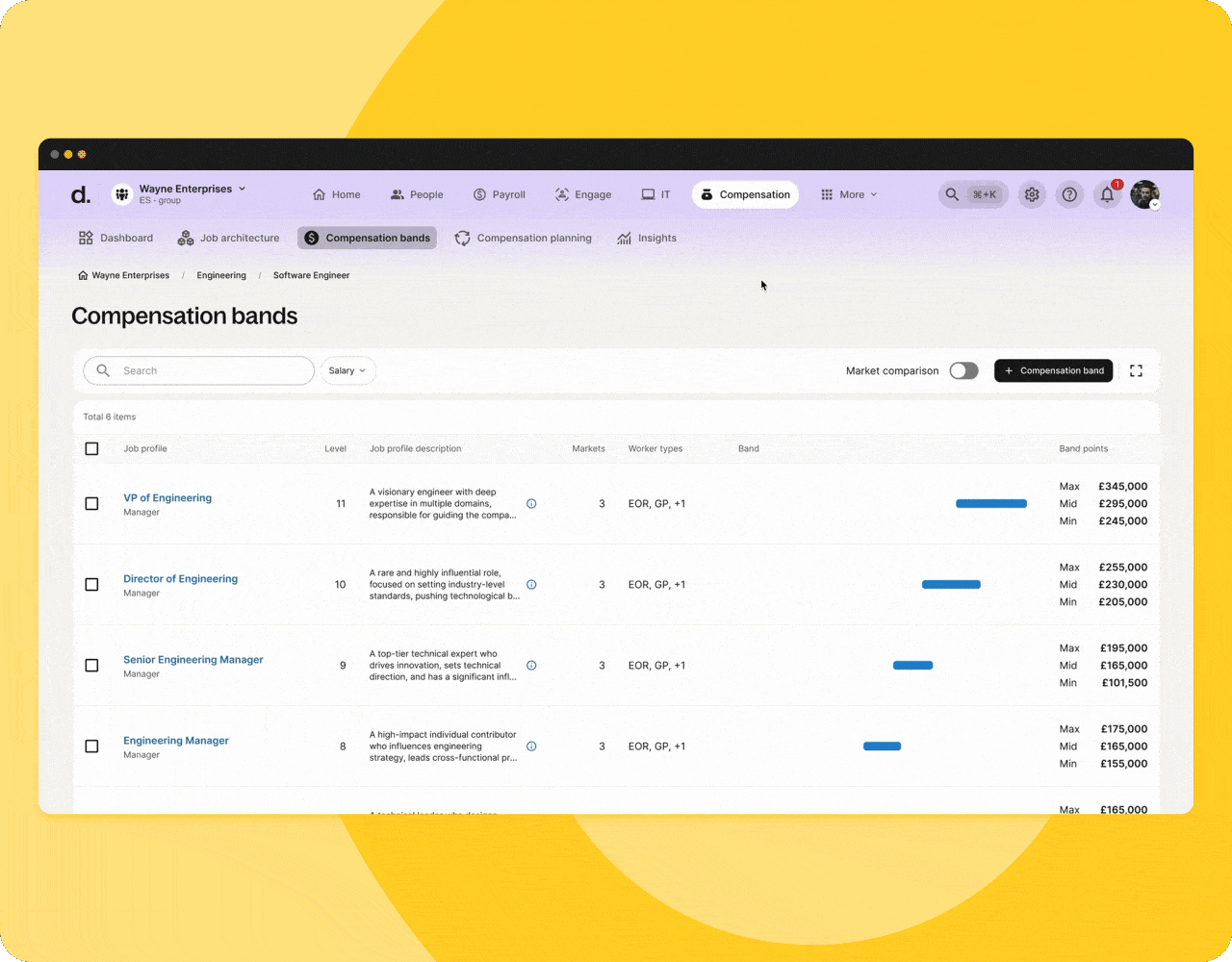
Deel Compensation: Define job architecture and associated salary bands
Deel Workforce Planning
Model, request, and approve headcount in one shared workspace. Deel Workforce Planning enables HR, finance, and hiring managers to forecast team needs, estimate costs, and approve new roles with complete visibility and no manual syncing across tools or teams.
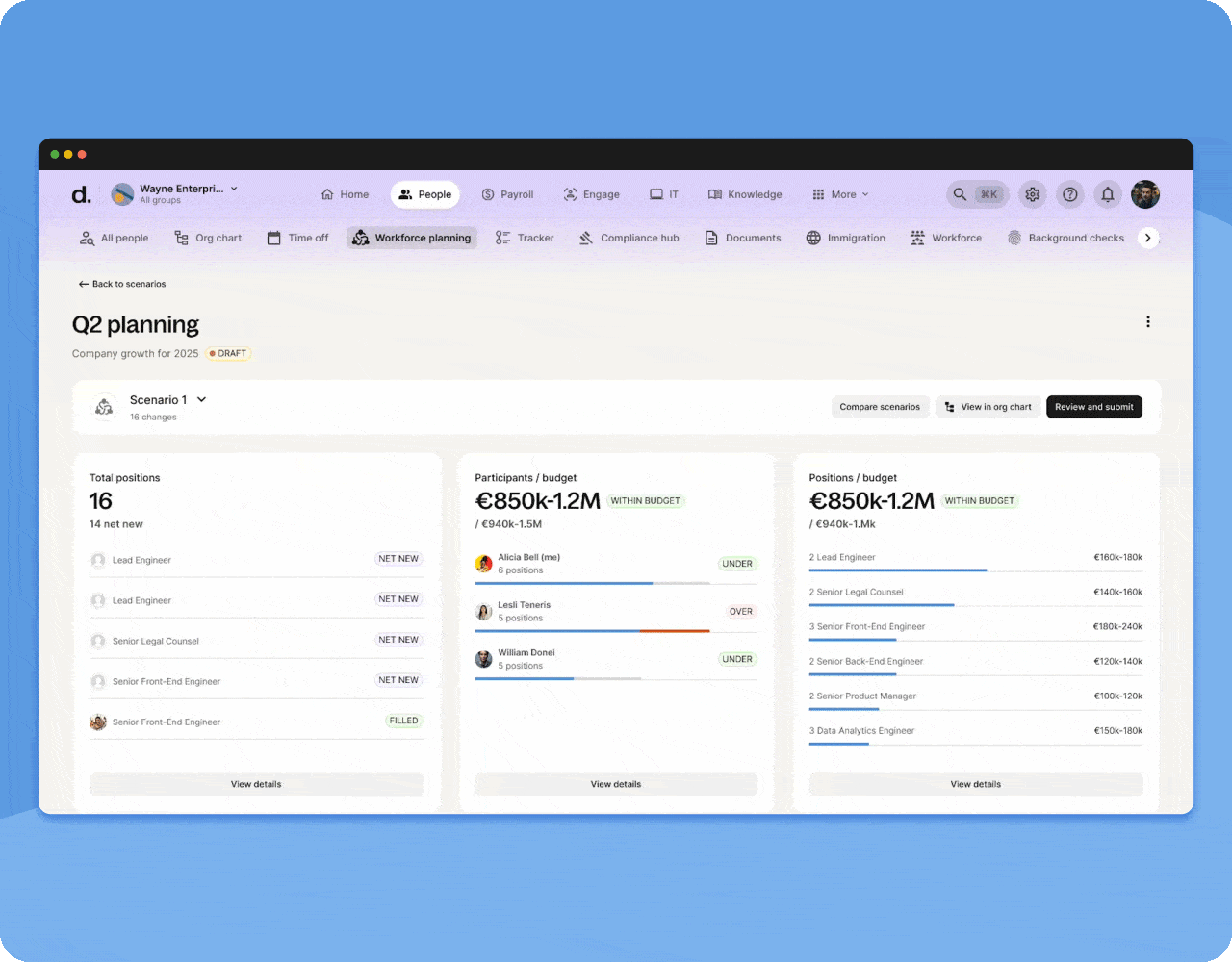
Deel Workforce Planning: Keep track of open headcount requests and budgets
Integration with other Deel products
All products in the Deel HR suite connect natively to other solutions in the Deel platform, like Gobal Payroll, IT, EOR, Contractor Management, and Immigration. Built-in AI-powered features also help teams move faster while staying accurate and aligned with local laws.
The result is a single, powerful system designed to scale as your business grows.
Ready to consolidate your mish-mash of HR tools into a clean, consolidated solution? Request a free Deel demo today.
FAQs
How does Deel HR pricing work?
Deel HR’s pricing is fair and transparent. It also scales with your business, meaning you only pay for the modules you need and can add or remove functionality at any time. Deel’s Global HRIS is always provided to our customers at no additional cost.
Is Deel HR only for global teams?
No, while Deel HR is an exceptional fit for global organizations, it’s also valuable for teams that operate within a single country or location. All businesses that use Deel HR will benefit from the automation, scalability, and ease of use of our tools.
Will we lose customization by switching to an all-in-one platform?
No, quite the opposite. We built Deel HR to reduce system complexity without sacrificing flexibility. You can tailor the platform to match your organizational structure, approval flows, and internal processes. With customizable fields, bespoke workflows, role-based permissions, and tailored modules, you get the control you need without the overhead of managing disconnected tools.
How does Deel HR help with compliance?
Deel HR is designed with compliance at its core. The platform includes localized contract templates, pre-set time-off policies based on local laws, and automated updates as regulations change. Teams can access Deel’s compliance knowledge hub for region-specific guidance, and workflows are built to align with legal standards across 150 countries. Whether hiring locally or expanding globally, compliance is built into every step, with no manual tracking required.
How does Deel HR support different worker types?
Deel HR is designed to manage contractors, EOR hires, and direct employees in one unified system. Along with storing worker records, its HR automation functionality connects your people to the workflows that matter: onboarding, time tracking, time off, performance reviews, payroll, and compliance. This means you can apply consistent processes across your workforce while still respecting the differences in contract type, location, or legal structure.

Lorelei Trisca is a content marketing manager passionate about everything AI and the future of work. She is always on the hunt for the latest HR trends, fresh statistics, and academic and real-life best practices. She aims to spread the word about creating better employee experiences and helping others grow in their careers.
